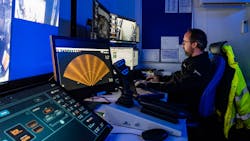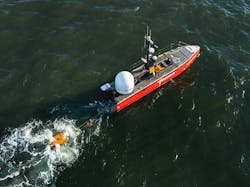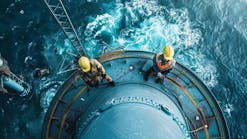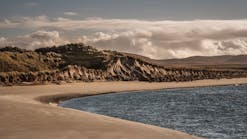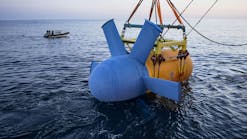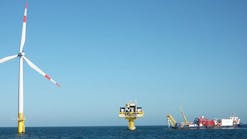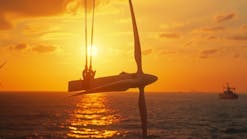Editor's note: A shortened version of this story first appeared in the September-October 2022 issue of Offshore magazine's first annual Offshore Wind Special Report. Click here to view the full Offshore issue or click here to view the special report.
By Ariana Hurtado, Editor and Director of Special Reports
In the offshore wind sector, the operations and maintenance (O&M) phase covers a breadth of services, such as inspections of turbines, foundations, cables and other components of the wind farm as well as making repairs or replacements. O&M costs are a large part of the total costs of offshore wind power, so new innovations for the O&M of turbines and wind farms are critical in ensuring a more cost-effective offshore wind sector.
The main O&M challenge for the offshore wind industry is data management, according to Wouter Maas, Fugro’s solution director of O&M offshore wind. The company can support all offshore renewables projects from initial site appraisal and design through to the installation and O&M stages. The company’s focus is on supporting the development, construction and extension of offshore wind farms.
The data Fugro has collected during the site characterization phase has almost doubled in recent years, and those data are accessible within hours rather than several weeks, he added.
“The number of sensors and high-resolution cameras being incorporated into the design of offshore wind farms are increasing to enable preventive maintenance strategies,” Maas told Offshore. “Interpreting and leveraging the data acquired during all phases and translating the data into actionable insights presented in a 3D model of the asset can help reduce the levelized cost of energy.”
Fugro strives to helps developers save on maintenance costs.
“Failure of an element of the offshore wind farm can cause a reduction or even a shutdown in the power production, which will lead to significant economic losses,” Maas said. “By combining our geotechnical and geophysical knowledge of the offshore wind farm site with accurate insights from structural monitoring, we help our clients create an optimized inspection plan allowing them to focus their attention on the right asset at the right time. This preventive maintenance strategy helps reduce the number of failures and associated maintenance costs.”
Noting other challenges, Peter Sutton, Ocean Winds’ O&M and assets management director, stressed the core issue developers are facing are with driving innovation (including hydrogen integration) and keeping the costs and time down. Ocean Winds is the 50:50 joint venture dedicated to offshore wind from EDPR and ENGIE.
Another hurdle during O&M strategy planning and execution is going into deeper water, he added.
“Some projects we are developing, like KF Wind, a 1.3-GW floating wind farm in Korea, are planned at an 80-km distance from shore,” Sutton told Offshore. “We are getting our O&M strategy ready for the road ahead, anticipating not only the distance but also the challenging climate.”
He also said it’s important to analyze the data from the O&M control center and work on prediction with the gathered information.
“The main objective is to keep the turbines running and have a smart approach to anticipating alarms,” Sutton said. “History, put together thanks to adequate data, helps you plan better. Planning will always be the answer to optimizing time and cost, and in our case, maximizing the generation of clean energy.”
Evolution of O&M technologies
Fugro’s Maas said more remote and autonomous technologies have been developed over the past year to support safe and sustainable O&M activities.
“This ranges from above water technologies, such as aerial drones to below water autonomous underwater vehicles and the development of complete uncrewed surface vessels [USVs],” he said.
Fugro’s Blue Essence is the first USV with an integrated onboard electric powered and remotely operated vehicle (eROV), of which three vessels have been successfully delivering subsea inspections in several countries around the globe.
He added, “There has been an increase in the number of remote operations centers [ROCs] and their satellite and processing capabilities to operate the assets remotely, process and deliver a huge amount of usable Geo-data to our clients in near-real time.”
The company has collected “Geo-data” from its site characterization surveys and ongoing monitoring activities, and it combines that rich data with inspection and monitoring data to assist operators in their decision-making.
“Inspections are a case in point. Rather than randomly selecting turbines to meet their annual inspection quota, an operator can connect insights from Geo-data and inspection data to optimize their inspection regime,” Fugro stated on its website. “They may decide to increase the inspection frequency to every two years for turbines located in an area of high seabed movement; but reduce it to every four years in locations where seabed movement is minimal.”
Accurate cable depth of burial assessment still is time consuming, Maas said.
“Smart combinations of cable monitoring and inspection has significantly improved over the recent years and helps increase the accuracy of the assessment,” he continued. “By also incorporating insights from Geo-data on seabed mobility and thermal conductivity, we can identify which cables have a higher risk of exposure or thermal hot spots. We can support offshore wind clients to take the next step in preventive maintenance strategies for cables.”
Ocean Wind’s Sutton added that O&M strategies in offshore wind energy have two main focuses: driving down costs and time. Therefore, strategies are “always evolving, with innovation as a forefront to reach these never-ending objectives,” he said.
“First, we need to mention the evolution of data. O&M technologies already allow us to collect smart data from our wind farms, compare and analyze,” he continued. “It empowers the wind farms to make faster decisions. Thanks to the powerful analytics, we are constantly improving how we manage and analyze data. The OEMs [original equipment manufacturers] have access to their own data, while as project owners, we centralize it at an entire project level, and therefore can drive our own algorithms that will be more precise and can predict smarter.”
Ocean Winds collects the data of its current 12.2-GW portfolio of projects in operation, construction or advanced development phases. This amount of data allows for more accurate predictions and therefore smarter O&M planning and strategy, Sutton said.
“Such predictions on conditions of the asset, for example, allowed the drive down of time-based maintenance and drive toward condition-based maintenance,” he said. “This allows empowerment for faster operational and commercial decision-making.”
The second strategy of focus, Sutton pointed out, is digitalization. In O&M, technicians can inspect with tablets in real time while being in the turbines, “recording better information as well as driving better owner technique and digitized methods,” he said. “Safer methods will also be the use of drones for these inspections. For subsea activities, the reduction of diving operations with personnel and the use of remote operated vehicle eliminates the exposure of high risks events.”
Regional differences
O&M techniques for offshore wind projects differ from region to region because of the availability of vessels, equipment and personnel, Maas explained, but also due to variations in site-specific weather (e.g., typhoons, hurricanes and lightning), metocean (wave heights, current and tides) and environmental conditions (bird migration routes and nature areas).
“O&M activities are of utmost importance for a lifelong sustained power production from offshore wind farms,” he said. “Therefore, it is important to adopt preventive maintenance strategies that can reduce the number of failures through a planned series of tailored O&M activities.”
O&M models should be agile and adaptable to local context and supply chain maturity, which is the goal of Ocean Winds. Sutton said the way the company does O&M is “more centralized, maximizing on synergies, as we have gathered expertise on our projects.”
“O&M strategies need to adapt to the local context of the wind farm, the maturity of the supply chain in the region and country, and, of course, the level of expertise and experience of the people working in the local O&M teams,” Sutton continued. “For instance, in European markets we can have a more flexible approach, thanks to the presence of mature companies, trained staff and technicians ready to intervene. You will internalize more easily the teams and capacitate. In markets where offshore wind is still at an early stage, you will face a higher level of complexity and risk and therefore need to adapt your strategy.”
ESG strategies
Fugro aims to achieve net-zero operations by 2030, while reducing its carbon footprint and ensuring personnel safety. “Our O&M strategy is built upon remote and autonomous solutions that incorporates our USV fleet specially designed with these exact requirements in mind,” Maas said. “The USVs can perform all subsea inspections with no personnel required within the hazardous offshore environment and who can manage operations within the safety and comfort of an onshore ROC.”
Fugro plans to have additional ROCs to supplement its current network of nine by the end of the year. The ROCs allow inspection operations to be carried out 24/7 and from anywhere in the world, Maas explained. “With a 95 % reduction in fuel consumption compared to traditional ROV supply vessels, our USVs combined with onboard eROVs deliver a low operational carbon footprint and with all personnel safely working from an onshore location,” he said.
Maas said Fugro invests heavily into its environmental monitoring capabilities to assess the environmental impact of offshore wind farms on the external environment.
“With the ever-growing ambitions and net-zero targets for the offshore wind industry, the correlation between offshore wind and nature is inevitable,” he said. “To become biodiversity positive, enhanced offshore wind farm designs are crucial to help offshore wind farm developers in achieving their biodiversity ambitions. We are committed to supporting our clients in protecting biodiversity from early project development through to the construction and operational phases of their project.”
Ocean Wind’s Sutton added that a low-carbon footprint is all about planning.
“In O&M, the biggest part of our work is logistics, and this is where we can focus to keep a low-carbon footprint and reduce risks for personnel,” he said. “The two are highly linked together. For instance, doing a smart planning can involve using drones rather than teams of technicians to inspect. This allows for a reduction in time and exposure to people, smarter reporting, while giving more time to repair. Finally, less weight on the boat, less trips and smarter vessel technology mean lower carbon emissions.”
Another example of low-carbon logistics is using hybrid vessels and gradually integrating hydrogen, Sutton added. Ocean Winds’ focus is on low-carbon initiatives and HSSEQ, developing standards in its operational system. The company is standardizing its best practices and driving alignments through smart tools that can be used 24/7 in all its projects worldwide.
Looking ahead
In looking to the future of this sector, Sutton said O&M strategies will continue to evolve and lessons learned from proven technologies can be applied to floating wind.
“The fixed monopiles or jackets are a mature system that we know how to operate and maintain,” he explained. “The strategies will be evolving for floating wind, with technology ready for commercial scale. We need to keep on working to drive operational cost down, and drive time down for O&M. However, learning from fixed technologies, we can transfer expertise into floating.”
Over the last two years, the amount of data Fugro collects for an average offshore wind farm has increased from 40 TB in 2020 to 100 TB in 2022, and the company is expecting it to continue increasing.
“Successful O&M strategies will also have to heavily rely on more remote solutions, which means transferring the skills from offshore to onshore ROCs and using more sustainable and lower fuel consumption USVs with greater over-the-horizon capabilities,” he continued. “We will also see island solutions, such as RoboDock, which allows uncrewed vessels to autonomously refuel at a location near the offshore wind farm or within the offshore wind farm itself.”
Fugro has offshore wind R&D projects in the works that include the continuous development of its USV and eROV fleet as well as developing its RoboDock. RoboDock is a floating, mobile and automated docking station for USVs, which will enable the company to reside or remain close to the offshore wind farm to reduce transit times, Maas explained. RoboDock will undergo testing this summer in the Netherlands.
“We believe it will contribute to a safer, faster and more sustainable O&M provision by enabling a short notice call-out to facilitate both scheduled and unscheduled operations seamlessly,” he said.
Maas said the future of offshore wind will be reliant on data management as well as remote and autonomous technologies. “This requires a big shift in mindset, regulations, training, working procedures and a lot of open conversations within the industry to discuss challenges, such as certification of the USV,” he concluded. “Only then we can continue to drive forward the energy transition contributing to a safer and sustainable world running on green energy.”
